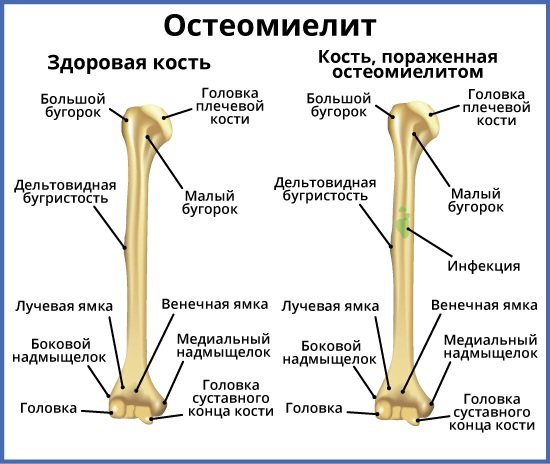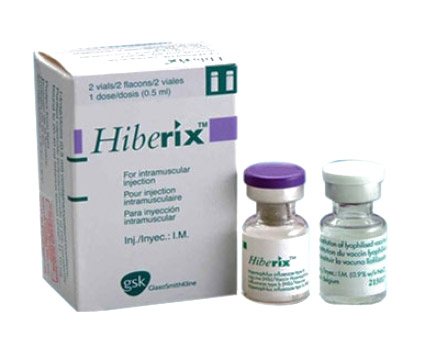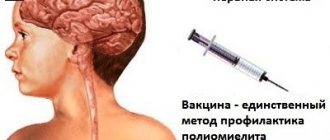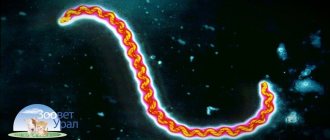General information
Haemophilus influenzae infection (Hib infection) is caused by Haemophilus influenzae type b. It can cause acute infectious diseases - purulent meningitis, pneumonia (pneumonia), epiglottitis (inflammation of the epiglottis), arthritis (inflammation of the joints), as well as purulent damage to the whole body - sepsis. Hemophilus influenzae infection is characterized by predominant damage to the respiratory system, central nervous system and the development of purulent foci in various organs. The bacterium H. influenzae is localized in the nasopharynx, from where it can be transmitted to other people by airborne droplets. Only a very small number of those in whom the pathogen is localized in the nasopharynx develop a disease with clinical manifestations. However, carriers of H. influenzae in the nasopharynx are an important source of spread of the pathogen.
Pathogenesis
The entrance gate of infection is the mucous membrane of the nasopharynx. The pathology is characterized by long-term persistence of the pathogen in the area of the infection gate. This is the latent stage of the disease. When the general resistance of the body decreases, it becomes manifest. An increase in the total microbial mass and the addition of a viral infection are conditions that accelerate this process. Epiglottitis, otitis, and sinusitis are associated with this localization of the pathogen.
The infection spreads lymphogenously or hematogenously through the surrounding tissues, causing the development of bacteremia, septicemia and inflammatory processes in the bronchi, lungs, and adipose tissue. In severe cases, hematogenous dissemination of microbes occurs with damage to joints, bones and internal organs.
Haemophilus influenzae penetrates the blood and persists asymptomatically until the number of microbial cells reaches its maximum. The bacillus then penetrates the blood-brain barrier into the central nervous system and causes the development of purulent meningitis.
Factors contributing to the development of hemophilus influenzae infection:
- Smoking,
- Alcoholism and drug addiction,
- Long-term antibiotic therapy
- Nervous tension and emotional outbursts,
- Hypo- or hyperthermia,
- Poor living conditions,
- Unfavorable environmental situation.
Chance of getting sick
There are several risk groups for this disease. Firstly, children most often suffer from this infection. According to various studies, carriage of Haemophilus influenzae in children reaches 50%. Infants 6-12 months of age who are bottle-fed and do not receive small additional amounts of maternal antibodies in breast milk have a particularly high risk of developing the most severe forms of infection - pneumonia and meningitis. For this reason, artificial feeding is an additional indication for vaccination against Hib infection, starting from 3 months of age.
People of extreme ages (children under 2 years of age, the elderly) and people with low socioeconomic status are also susceptible to hemophilus influenzae infection. In addition, people with low socio-economic status, extremely weakened and suffering from alcoholism, patients with lymphogranulomatosis (Hodgkin's disease), sickle cell anemia are susceptible to the disease; persons who have undergone splenectomy (removal of the spleen).
The incidence increases in late winter and spring. In recent years, the incidence of morbidity in adults has increased markedly.
What is hemophilus influenzae infection?
Haemophilus influenzae in medicine is called influenza infection. The disease most often affects the organs of the respiratory system and provokes a strong infectious inflammatory process. In some situations, other internal organs also suffer, and purulent foci form in them.
The causative agents are pathogenic bacteria of the hemoflux class. The source of infection is humans. The disease is accompanied by characteristic symptoms, for which it is important to consult a doctor promptly.
An initial examination will help the specialist make a preliminary diagnosis and send the patient for the most informative studies. The results obtained are taken into account when selecting a treatment regimen.
Symptoms
The duration of the incubation period is difficult to determine, since the disease is often a consequence of the transition of a latent infection to a manifest one. Both a local inflammatory process of the mucous membrane of the upper respiratory tract and diseases caused by hematogenous dissemination can develop.
Complications after an illness
Often, hemophilus influenzae infection occurs in children in the form of a common respiratory infection with corresponding symptoms. However, cases of more severe forms of infection are not uncommon. The most severe form of Haemophilus influenzae infection is purulent meningitis. According to some data in Russia, in children under 6 years of age, up to a third of all cases of purulent meningitis are caused by Haemophilus influenzae type b. Haemophilus influenzae meningitis is difficult to treat because its causative agent produces enzymes that make it resistant to antibiotics (about 20-30% of Haemophilus influenzae bacilli isolated from patients are not sensitive to many antibiotics). Therefore, treatment results are not always successful, and mortality in severe forms of the disease can reach 16–20%.
A third of patients who have had hemophilic meningitis develop irreversible neurological complications - seizures, delayed neuropsychic development, deafness, blindness, etc.
Pneumonia caused by Haemophilus influenzae type b occurs predominantly in children aged 2 to 8 years, and its course in 60% of cases also has various complications, including those affecting the heart and lungs.
Up to half of all purulent infections of the ear, throat, and nose are associated with hemophilus influenzae infection, in particular, recurrent purulent otitis (inflammation of the middle ear) and sinusitis (inflammation of the paranasal sinuses).
Hemophilus influenzae sepsis most often develops in children 6-12 months of age who are predisposed to this disease. It proceeds violently, often like lightning, with septic shock and rapid death of the patient.
Purulent arthritis is a consequence of hematogenous introduction of Haemophilus influenzae and is often accompanied by osteomyelitis.
Diagnostics
Infectious disease doctors and pediatricians are involved in the diagnosis and treatment of hemophilus influenzae infection. They examine patients, listen to complaints and study the results of laboratory and instrumental examinations. After collecting anamnesis and assessing the condition of the skin, doctors measure blood pressure, temperature and pulse. Often additional consultation with an ENT doctor, gynecologist, surgeon, neurologist, ophthalmologist, or pulmonologist is required.

Laboratory research:
- General analysis of blood and urine - to determine signs of inflammation,
- PCR – to detect pathogen DNA,
- Culture of sputum, cerebrospinal fluid or throat discharge - to isolate the pathogen,
- Serological tests - to determine antibodies in the blood,
- Immunodiagnostics – detection of the capsular antigen of Haemophilus influenzae using ELISA.
Instrumental measures are carried out to confirm the expected diagnosis and identify existing complications. The most common and informative are: ultrasound, radiography, CT and MRI.
Microbiological examination of clinical material is the main diagnostic method that allows one to isolate the rod from a patient. Upper respiratory tract discharge, pus from the ear, sputum, cerebrospinal fluid, joint fluid, and blood are delivered to the bacteriological laboratory for analysis. The biomaterial is studied under a microscope and inoculated on nutrient media. For inoculation, chocolate agar with growth factors is used. After isolating a pure culture and identifying the pathogen, a test for antibiotic resistance is performed.
Treatment
Haemophilus influenzae Hib infection is difficult to treat, since Haemophilus influenzae is record resistant to antibiotics. For this reason, even timely treatment with modern antibiotics is often ineffective. Penicillin antibiotics, erythromycin, chloramphenicol, tetracycline - the percentage of Haemophilus influenzae resistance to them is 80-100% (of the number of isolated bacterial samples). Without etiotropic therapy, some forms of hemophilus influenzae infection (meningitis, epiglottitis) almost always end in the death of the patient. It is necessary to begin treatment for hemophilus influenzae infection as early as possible.
What diseases does it cause?
Haemophilus influenzae, penetrating the human body, causes certain pathological diseases:
- purulent arthritis;
- acute pneumonia;
- purulent meningitis;
- epiglottitis (a disease that is accompanied by an inflammatory process in the epiglottis);
- osteomyelitis;

- septicemia (a pathological condition in which blood poisoning occurs and weakness appears as a result of a developing inflammatory process);
- cellulite (subcutaneous fat tissue becomes inflamed).
Otitis, sinusitis, pericarditis, pleurisy are also a consequence of the development of Haemophilus influenzae in the human body. Each disease is accompanied by characteristic clinical symptoms.
There are also carriers of Haemophilus influenzae infection. The person feels well, there are no clinical signs, but he is dangerous to others. The carrier constantly releases pathogenic agents into the environment.
Effectiveness of vaccination
In 2000, before the widespread introduction of Hib vaccine in resource-limited countries, Hib disease accounted for 8.13 million cases of serious illness in children aged 1–59 months (range, 7.33–13.2 million cases). ) and 371,000 deaths (fluctuation amplitude – 247,000=527,000). By 2008, when 136 WHO Member States introduced the Haemophilus influenzae vaccine, there were an estimated 203 000 deaths due to Hib infection in children under 60 months of age (range 136 000–281 000).
The effectiveness of Hib vaccines is 95-100%; the protective antibody titer lasts for at least 4 years.
Among vaccinated people in 10 European countries, Israel and Australia, Hib infection developed with a frequency of only 2 cases per 1 million; 18% of these children had problems, including prematurity; 33% had low immunoglobulin levels.
TYPES OF VACCINES
The vaccine against Haemophilus influenzae is a drug developed on the basis of polysaccharides of the capsule of the pathogenic microorganism conjugated with tetanus toxoid proteins. This makes it possible to convert microbial particles into an antigen, which contributes to the formation of a pronounced immune response. Conjugation also helps reduce the reactogenicity of the vaccine preparation, making it as safe as possible for the fragile organism of infants.
Important! The vaccine against Haemophilus influenzae has a unique effect, leading to an exponential increase in antibodies against the infectious agent if the drug is administered repeatedly.
The following vaccines against hemophilus influenzae are widely used in Russia:
- Mono-vaccine Act-HIB (manufactured in France). The drug is created exclusively on the basis of Haemophilus influenzae antigens. This vaccine has been used to prevent Haemophilus influenzae for many decades and has proven its effectiveness. Therefore, it is widely used to form stable immunity in children under 12 months;
- Monovaccine Hiberix. The vaccine was manufactured in Belgium and is an analogue of Act-HIB. In Russia, the drug has been used for a relatively short time;
- Polyvalent drug Pentaxim. The French vaccine will protect the child’s body from 5 serious diseases: polio, whooping cough, Haemophilus influenzae, tetanus, diphtheria. However, the pertussis component increases the reactogenicity of the vaccine preparation. Therefore, vaccination against Haemophilus influenzae infection will lead to the development of pronounced side effects;
- Combined vaccine Infanrix penta. The drug, produced in Belgium, is an analogue of Pentaxim.
Due to their ease of use and effectiveness, combination vaccines are widely used for vaccination against Haemophilus influenzae in district clinics. However, parents have to purchase the vaccine themselves at the pharmacy.
Vaccines
Currently, the only way to prevent this infection is vaccination. According to WHO recommendations, vaccination against Haemophilus influenzae is recommended for all children. The effectiveness of vaccination today is estimated at 95-100%. There have been numerous trials of polysaccharide conjugate Hib vaccines in Europe and North America. In particular, a clinical trial in the UK (1991-1993) showed an 87% reduction in the incidence of haemophilus influenzae meningitis. In Holland, during a similar study, a complete absence of cases of meningitis of hemophilic etiology was recorded within 2 years after the start of immunization.
Modern vaccines are chemically linked antigens of the Haemophilus influenzae capsule and tetanus toxoid, which is necessary for the main antigen to produce immunity in children under 18 months of age.
Recommended calendars. WHO recommends one of the following vaccination schedules against Hib infection:
- 3 doses as part of the primary vaccination course without a booster dose (3p+0);
- 2 doses as part of the primary course of vaccination and a booster dose (2p+1);
- 3 doses as part of the primary course of vaccination and a booster dose (3p+1).
In countries where the peak burden of severe disease from Haemophilus influenzae type b occurs in young infants, early administration of 3 doses of vaccine may be beneficial.
By Order of the Ministry of Health of the Russian Federation No. 125 of March 21, 2014, vaccination against hemophilus influenzae type b was introduced into the National Calendar of Preventive Vaccinations of the Russian Federation for children at risk.
More about vaccines
Prevention
Currently, specific prevention of hemophilus influenzae infection has been developed and introduced into the practice of clinicians. Timely vaccination is the optimal means of protection against infections caused by this pathogen. The vaccine consists of fragments of a bacterial capsule and does not contain a live pathogen. Due to this, it is administered to children and people with reduced immunity.

There are several foreign and domestic vaccines:
- "Akt-Hib"
- "Hiberix"
- "Pentaxim"
- "Infanrix Hexa"
- “Haemophilus influenzae type b conjugate dry vaccine.”
The vaccines listed above have been licensed. A specific drug name is used against each type of Haemophilus influenzae. The vaccine is given to children under 5 years of age, as well as to persons at risk.
Nonspecific prevention consists of strengthening the immune system. Emergency prevention is carried out after contact with a sick person. To do this, doctors recommend taking a course of antibiotics.








